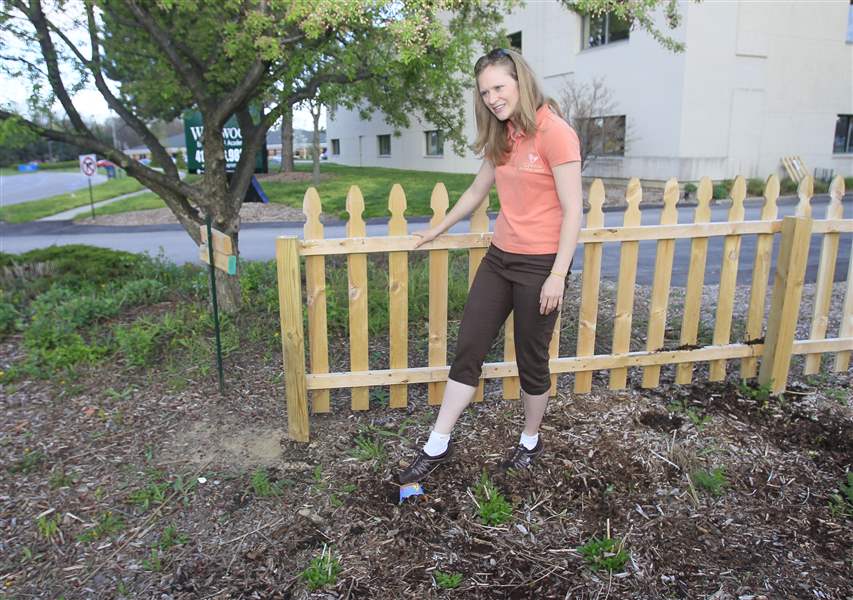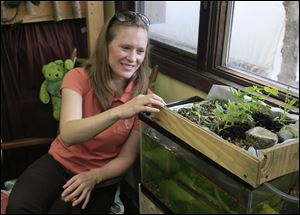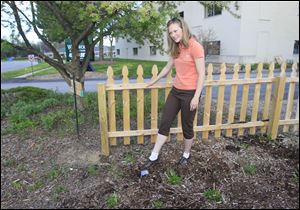
WEED IT & REAP
Laura Schetter: Digging in the soil and raising a plant is therapeutic
5/8/2013
Laura Schetter in the rain garden at the school. Laura Schetter is a third grade teacher at Wildwood Environmental Academy and one of the advisors to the Eco Club at the school.
The Blade/Jetta Fraser
Buy This Image

Laura Schetter next to a fish tank with tilapia. On top is a garden. The water from the tank goes into the garden, where the roots of the plants clean the water which is then returned to the tank.
Name: Laura Schetter is a third-grade teacher/conservation educator/co-leader of the Eco Club at Wildwood Environmental Academy in Maumee and also teaches four online graduate courses for Miami University's Project Dragonfly. The Holland resident was named the Conservation Educator of 2012 by the Lucas Soil and Water Conservation District.
Garden specs: At school, 25-by-5 feet and 20-by-6 feet. We have a rain garden, a native-plants garden, and a greenhouse. My home gardens are 5-by-15 feet, 10-by-5 feet, and 20-by-3-feet and they're surrounded by 18-inch fences. My hyper dog, Chelanna, loves to run and could easily jump over the fences but seems to sense my passion for the garden so she doesn't. Squash once grew beyond the bed and she gingerly stepped over each and every vine.
When did you start gardening? When I became a homeowner, five years ago.
What do you grow? Rare and endangered species of native plants (mountain mint and lupine), veggies, herbs, and heirloom tomatoes (garden peach, Rutgers, pink brandywine).
PHOTO GALLERY: Weed It & Reap with Laura Schetter
Favorite plant: Kale because it comes in so many varieties. I grow dwarf blue curled. It's a cold crop and can be planted in early spring and again in late summer and is able to withstand early frosts. It can be harvested repeatedly and is a super food packed with nutrients. I eat it raw, sautéed, boiled, baked into dishes, and as chips (I dry kale leaves in my food dehydrator and sprinkle them with salt).
Give us a tip: Plan your garden way ahead of time; be thoughtful, research, and when things don't go as planned, be flexible. This goes for gardening with children, too. I recommend companion planting in which you put complementary plants next to each other. The idea goes back to the Native Americans' Three Sisters' technique of growing squash, corn, and beans in one mound to help each other grow. Companion planting can also keep pests away from the main crop. Tomatoes, peppers, and eggplants are good neighbors, but don't grow onions or other root veggies near them. Basil and tomatoes grown near each other are said to enhance each other's flavors. Spinach and strawberries are good companions as are strawberries with beans and peas.

Laura Schetter in the rain garden at the school. Laura Schetter is a third grade teacher at Wildwood Environmental Academy and one of the advisors to the Eco Club at the school.
Hours spent gardening: Anywhere from 15 minutes to two hours a day, depending on how much therapy I need!
Annual expense: I spend about $50 a year on composted cow manure and topsoil to enrich my beds. I dry and save a lot of my own seeds. It's priceless to me to have home-grown food at my fingertips.
Challenges: I get so attached to my garden that it's hard not to be disappointed when something doesn't produce or dies off: aphids on my tomatoes, mildew that kills the squash, watermelons that got frosted before maturation because I planted them too late; a cucumber vine that just didn't produce. Gardening is just one big experiment. I'm constantly trying different things and learning as I go.
I'm proud of: My reputation as a passionate gardener and conservationist. I love being the one to listen when kids and adults at school seek me out to tell me their garden stories or ask me questions. One day a kid saw me in the hallway and called me "Mrs. Green." My students are raising endangered lupine plants for a conservation project with the Toledo Zoo, which will plant them in the threatened ecosystem of the Oak Openings habitat. Also, this summer, I'm excited to be leading a 10-day Miami U field trip to Baha, Mexico to explore desert ecology.
What I've gotten out of gardening: Doing my master's work at Miami's Project Dragonfly, I researched and learned that nature heals. Kids feel, behave, and even concentrate better when they spend time outdoors. Digging in the soil and raising a plant is therapeutic. I'm passionate about teaching them gardening because it guides them to care for the earth, its resources, and its beauty.